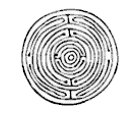Ceramic Age/Pre Columbian

By 200 BC, seafaring people from the lowland region of the Orinoco River, South America migrated into and established settlements as far north as Puerto Rico. As a horticultural people, they innitially occupied wetter and more fertile islands that best accomodated their needs. These Amerindians were an Arawak speaking culture. They brought with them many traditions including pottery making. Their unique and highly decorated pottery has enabled archaeologist to recognise their sites and to determine their places of origin.
The origins of the Island Arawaks have been traced to the lower Orinoco River near the modern settlements of Saladero and Barrancas in Venezuela. As we do not know what they called themselves, they have been given the name of the sites where their unique pottery styles were first recognised. The suffix "oid" has been in this cultural classification. Hence, the name Saladoid is used by archaeologists, to identify the peoples of the early ceramic age.
Pre-Columbian Trade and Exchange
Over the years, archaeological excavations at Saladoid sites on Antigua have uncovered a number of ornaments including beads and pendants that were made from a variety of local and imported minerals and stones. Among these exotic artifacts were fragments from broken axes that were made from jadeite. While we have sourced the raw materials for the ornamental items, such as carnelian, barites, calcite and diorite to Antigua and nearby islands, the source and origins of the jade axes remained a mystery. Fortunately, jadeite is unique in its composition for jade from each source differs considerably from each other. This meant that the jadeite from Antigua could be sourced by minerologists to its area of origin. Analysis by Dr. George Harlow of the American Museum of Natural History, on samples recovered from Antiguan Saladoid sites by Dr. Murphy indicate that the source of the Antiguan jadeite is likely south of the Montagua Fault Zone in Guatemala. This result presents several issues for investigation, including the route of exchange and interaction between the diversity of cultures between Central America and the Eastern Caribbean.
Ceramic Age/Pre Columbian Sites: Cades Bay | Doigs | Elliot's | Green Castle Hill | Indian Creek | Long Island | Mill Reef | Royall's
Introduction | Archaic Age | Ceramic Age/Pre Columbian Saladoid | Post Saladoid | Historical Period | Common Myths
Archaic Age

Previously known as the Siboney, the Archaic Age inhabitants represent the first humans known to have settled on Antigua. The first, or oldest site, is at Little Deep in Mill Reef (3,100 BC). The Archaic Age people are believed to have originated in South America. They are known archaeologically by their distinctive lithic technology; the manufacturing of flint blades from prepared cores. Interestingly, some aspects of their lithic technology on Antigua closely resembles that of the Greater Antilles, and no Archaic Age sites have been found south of Antigua with a material culture that is comparable to those of Antigua. Large macro blades, backed knives, ground stone tools, such as conical shaped pestals and earred axes are typical of this tradition. They generally settled directly on the seafront in areas rich in shellfish and marine resources. It is not known what plants they utilised or grew as food, however, the significant numbers of grinding tools suggest that plants were being processed. Their sites are typically delineated by shell middens and patinated flakes made from Long Island flint . Over fifty sites have been catalogued on Antigua.
Archaic Age Sites: Winthrope's Bay; Deep Bay (1,387BC); Jolly Beach (1,775 BC); Twenty Hill (2,910 BC ); Hand Point (1,317 BC); Cloverleaf (383 BC); Five Island Gap (71 BC).
Introduction | Archaic Age | Ceramic Age/Pre Columbian Saladoid | Post Saladoid | Historical Period | Common Myths
Archaeological Background
Introduction
With the subsequent discovery and settlement by European Nations, the islands and the native peoples were changed forever. In the quest to colonise and extract maximum profits, many new species of plants and animals were introduced, as were millions of enslaved Africans who were forced to work on the newly established plantations, mines, and estates. Ultimately, labour had to be sought in China, India, and Portugal, and by the dawn of the 20th century, the Caribbean was a melting pot of cultures and traditions.
Throughout the seventeenth and eighteen centuries, the islands generated vast wealth for their European colonial Nations. As such, they were heavily defended, fortified, and the source of much conflict. On Antigua, a dockyard was established for the repairing and provisioning of ships for the Royal Navy. This island was particularly heavily fortified and many barracks were built to house the British Regiments stationed there.
Needless to say, Antigua is rich in history. However, much of what is known is derived from the early historical accounts written by the English colonists, missionaries, and planters. Archaeology in the Caribbean is in its infancy, yet it is already exploring and providing an alternative perspective. A significant contribution has already been made into our understanding of the pre-Columbian cultures of the Caribbean.
Introduction | Archaic Age | Ceramic Age/Pre Columbian Saladoid | Post Saladoid | Historical Period | Common Myths






